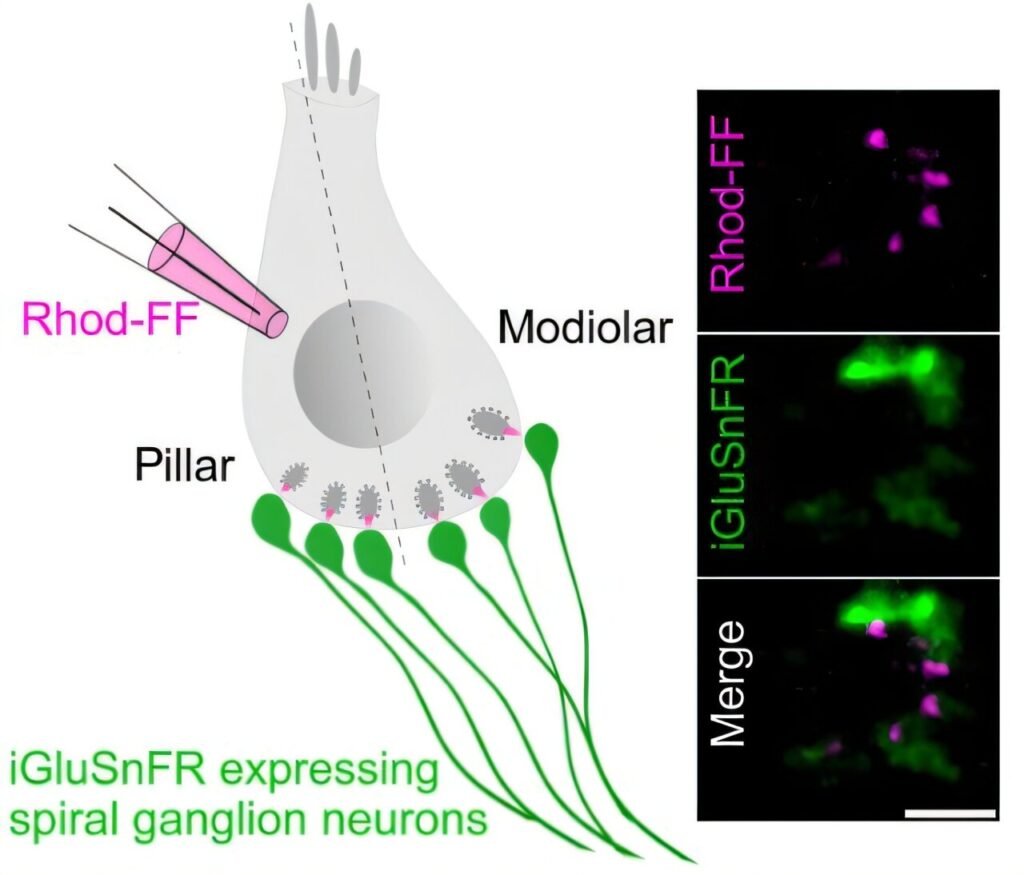Researchers at the University Medical Center Göttingen (UMG) have made a significant discovery regarding how a small alteration in a single ion channel can impact the sensitivity of sensory cells in the inner ear. This alteration can lead to enhanced perception of even soft sounds, such as whispers, but can also result in prolonged overloading, potentially leading to long-term hearing loss. These findings shed light on how sound information is encoded in the ear and have been recently published in the prestigious journal Science Advances.
In the inner ear, sensory hair cells play a crucial role in converting sound waves into electrical signals. When sound waves reach these cells, their hair bundles react accordingly based on the sound intensity. This movement of the hair bundles activates calcium channels at the synapses of the hair cells, allowing for calcium influx. This influx triggers the release of a neurotransmitter, which then transmits the electrical signal to auditory nerve cells. Subsequently, the signal is transmitted along the auditory pathway to the brain for sound perception.
Specifically, calcium channels like CaV1.3 are vital for transmitting signals from sensory hair cells to auditory nerve cells. These channels are highly sensitive to voltage changes in the cell, which are triggered by incoming sound signals. Any dysfunction in CaV1.3 channels can result in various hearing impairments, ranging from minor issues to complete deafness. Mutations in the genetic blueprint of CaV1.3 can lead to the formation of dysfunctional channels, causing hearing problems.
A research team led by Prof. Dr. Tobias Moser from the University Medical Center Göttingen (UMG) has studied the impact of a genetically modified CaV1.3 variant, known as CaVAG, on sound processing in an animal model. The CaVAG variant, characterized by a slight change in the calcium channel blueprint, exhibits increased sensitivity to voltage changes in sensory hair cells compared to the intact channel. This increased sensitivity can lead to earlier channel activation in response to the same stimulus, affecting downstream auditory nerve cells.
The study revealed that the heightened sensitivity of the CaVAG variant has a direct influence on the sensitivity and response behavior of auditory nerve cells to sound signals. While this increased sensitivity may improve the perception of soft sounds in the short term, the research uncovered that some synapses between sensory hair cells and auditory nerve cells could lose their structure over time due to overactivation caused by the mutation.
Individuals carrying the CaVAG variant may be exceptionally sensitive to sound and susceptible to noise-induced damage. Long-term monitoring and preventive hearing protection are recommended for such individuals to mitigate the risk of hearing loss. This groundbreaking research provides valuable insights into the molecular mechanisms underlying hearing damage and emphasizes the importance of protecting one’s hearing in everyday noise exposure.
For more information on this research, you can refer to the published article in Science Advances titled “Gating of hair cell Ca2+ channels governs the activity of cochlear neurons” by Nare Karagulyan et al. (DOI: 10.1126/sciadv.adu7898). This study was conducted in collaboration with researchers from the Shanghai Institute of Precision Medicine in China and the University of Innsbruck, Austria.
This research, conducted by the University Medical Center Göttingen, presents a significant advancement in our understanding of how cellular calcium channel dysfunction can impact hearing. The study underscores the importance of ongoing research in audiology and highlights the need for proactive measures to safeguard hearing health in the face of genetic variations that can affect auditory function.


